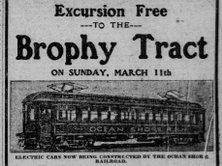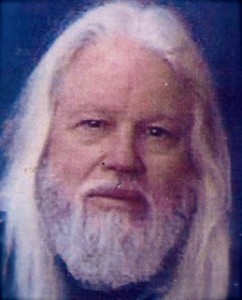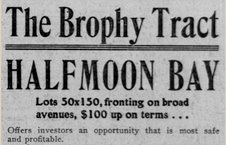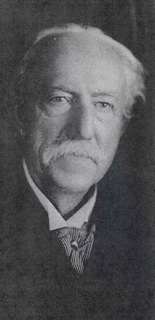Story by John Vonderlin
Email John ([email protected])
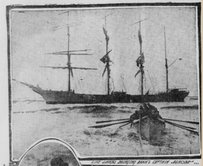
Hi June,
This article from the September 27th,
1903 issue of “The Call,” highlights how
dangerous our coast was for ships, even
after lighthouses were built and an early
version of the Coast Guard was created.
With all the dangers they faced, no won-
der these folks believed in Sea Serpents,
as my next posting will detail.
Enjoy. John
DECEIVED by the dense fog that
has lain low over the ocean along
the coast for the last two days,
the British four-masted bark
Gifford, seventy-five days out
from Newcastle, New South Wales, with
a cargo of coal for this port, went ashore
on Mussel Rock on Friday evening at 6
O’clock and is now lying at the mercy
of th« wind and waves, a wreck. The
entire crew of the bark saved their lives
after a battle with the waves.
The first news that the Gifford was
ashore was made known yesterday morn-
Ing at 8 o’clock, when she was sighted
by the lookout of the South Side Life-
Saving Station five miles north of the
wreck. The alarm was at once given and
in a short space of time the lifeboats
from, the South Side, Golden Gate and
Fort Point stations were launched and
proceeded to the scene of the disaster.
Telephone messages were sent to the
Merchants Exchange and to the offices
of the tugboat companies and two hours
after the news of the wreck was made
known the tugs Sea Rover, Relief, Sea
King and Defiance were pitching and tos-
sing close to the ill-fated bark.
STRUCK IN DENSE FOG.
At the time the Glfford went ashore
the fog was so dense that it was impos-
sible for those on board to see a ship’s
length ahead. Men on the masthead and
forward on the bark could not detect the
noise of the breakers owing to the thun-
der of the sea, and though the captain
of the vessel, David Michie, knew that
he was in the vicinity of the Golden Gate,
he did not know that he was south of
the haven of safety and in the twinkling
of an eye, the valuable bark and her cargo
were lost to the use of man. The Gif-
ford ran with a crash upon the sharp
rocks that lie twelve miles south of the
Cliff House.
All hands were on deck at the time of
the disaster. First Officer Harry Lav-
erick was on watch when the bark went
ashore. At 6 o’clock in the evening the
watches were changed, and owing to the
dense fog Captain Michie decided to take
in the sail and put his vessel about, fear-
ing that he might be too close to the
coast for safety.
While the sailors were aloft taking in
sail the first officer threw the sounding
lead and discovered that he was in shal-
low water. His warning cry to Captain
Michie came too late. The Glfford piled
on Mussel Rock and her forward and
middle compartments were pierced by the
sharp pinnacles.
ROCKETS FIRED FOR HELP.
The order was at once given to man
the bark’s lifeboats and prepare to launch
them. Good order was maintained, and
after finding that the vessel was not
taking much water in the wells, Captain
Michie decided to keep his men aboard
and signal for for assistance.
Through the dark watches of the night
the spray-drenched crew of the Gifford
clung heroically to their vessel. Rockets
were sent up at frequent intervals for
two hours after the vessel struck. .
Flares were burned from 9 p. m. until
midnight, but no answer came from the
shore. Captain Michie and his crew claim
that while the fog was very dense pre-
vious to the disaster, the mist cleared
away shortly after the vessel struck and
all through the night they could see a
white fixed light some miles up the beach.
If the fog cleared as Captain Michie and
his men claim it did,it seems incredible
that the lookout of the South Side Life
Saving Station did not notice the rockets
and flares from the wrecked vessel. As
in the case of the steamship Rio de Jan
eiro no help from the life saving men
reached the unfortunate mariners until
some hours after the disaster took place.
The bravery of the life saving crews on
this coast is not to be questioned for an
instant, but the lookout system seems to
be woefully at fault. If the Gifford had
been a passenger ship laden with many
human lives, another tale of awful loss
would have been added to the list of dis-
asters on this coast.
WALKED MILES FOR AID.
At 7 o’clock yesterday morning Captain
Michie ordered that two of his life boats
be launched and a landing made on the
shore. The boats had a terrible struggle
with the waves and the sailors were
drenched to the skin by the waves dash-
ing over the boats.
When a landing was finally made Sec-
ond Officer Ernest Clarke, with sailors
Lewis Berloner and carpenter E. Math-
ews, climbed the steep bluff and made
across the range in the direction of
Colma. Their mission was to summon
assistance and also to get water for the
crew, as the barrels in the vessel’s life
boats were filled with salt water and not
with the fresh liquid as demanded by law.
Captain Michie denied last evening that
the barrels were filled with salt water,
but the fact remained that the only water
the stranded sailors had to drink on the
beach was the scant supply carried by
some of the crew for miles across the hills
to the scene of the wreck.
At 8 o’clock yesterday the lookout of
the South Side Life-saving Station dis-
cerned the Gifford through bis marine
glass and gave the alarm. When the four
tugs and the three life boats arrived at
the scene of the wreck all the crew were
ashore with the exeception of Captain
Michie, First Officer Harry Laverick and
two of the sailors.
TUGS FAIL AT RESCUE.
The life boats went alongside the
stricken vessel while the tugs lay some
distance off. The Gifford was lying
broadside on to the heavy waves that
dashed with terrific force on the sides
of the vessel. Each successive wave
seemed to drive the unfortunate bark
closer to the shore and lessen her
chance of being saved by the tugs.
It was decided that an attempt should
be made at high tide to pull the Gifford
from her position on the rocks. The tugs
were assisted by the life saving crews in
making hawsers fast to the stranded ves
sel. The tide was at its highest at 3
o’clock yesterday afternoon and half an
hour before that time the tugs steamed
with every pound of steam in their boilers,
trying, to pull the Gifford from Mussel
Rock. The hawsers broke like strings
and again the life boats tossed and
tumbled in the heavy surf and carried
the lines from the tugs to the Gifford.
Another attempt was made to pull the
Glfford from the rocks exactly at high
tide, but it failed. The rocks held their
prey with tenacious hold and the work
of the tuffs was of no avail. A second
time the hawsers parted and it was then
seen that the Gifford was doomed to de-
struction. The tugs steamed for the har-
bor and the life boats went to work to
bring Captain Michie and his comrades
from the doomed vessel to the shore, to-
gether with their belongings.
Twice the life boats, in charge of Cap-
tain Varney and Captain Grunbeck, made
the perilous trip from the Gifford to the
shore. When the Gifford struck she was
about two hundred yards from the beach,
but the constant pounding of the waves
for twenty-four hours had placed her last
evening one hundred yards nearer shore.
When Captain Michie of the Glfford
came ashore last evening from his
wrecked vessel he made the following
statement:
“We left Newcastle, New South Wales,
seventy-five days ago, on Friday. We
did not sight land, with the exception of
a small island, until we got off the coast
of California. On Thursday morning
last we could discern the coast through
the haze. I took my bearings by thesun
on Thursday noon and shortly after that
the foe settled down on us and it was
thick until after we went ashore. I as-
sumed that we were some distance from
the Golden Gate, but we could not see
any lights and did not hear any of the
fog whistles. After we struck we sent
up rockets and burned flares, but we re-
ceived no answer from the shore. The
fog cleared after we struck and we could
see a fixed white light some distance
north of us. I deny that the barrels on
our lifeboats were filled with salt water.
It may be that salt water got Into the
barrels when the boats came ashore. I
do not care to make any further state
ment until I have seen our local agents,
J. J. Moore & Co
Captain Michie proceeded to the South
Side Life-saving station and at that point
the crew of the station put him aboard
an Italian fishing boat bound for the
harbor. At a late hour last night word
was received from the South Side Life
saving station that the entire crew of the
Gifford was still on the beach near the
wreck and that they would remain there
all night and would be brought into the
city to-day. Captain Michie could not
be located last night, though it was
known that he was landed at Meiggs
wharf by the Italian fishermen on whose
boat he came into the harbor.
FIRST MATE’S STATEMENT
First Officer Harry Laveflck, who was
in charge of the watch when the Gif-
ford struck, made the following state-
ment when he came ashore last evening:
“The fog was so dense yesterday that
we could not see 100 feet ahead. We were
steering northeast by east just before we
struck. We heard a fog whistle at 3
o’clock in the afternoon, and we were not
sure what whistle it was. We could not
see any lights on shore when it got dark.
From our dead reckoning and the bear-
ings we secured on Thursday by the sun
we thought we were heading directly for
the Golden Gate.’ I was taking a sound-
Ing Just as the vessel struck.”
The British ship General Gordon, from
Newcastle, N. S. W., also had a narrow
escape from going on the rocks the same
time the Glfford did. The two vessels
were in sight of each other since Tues-
day last, and at the time the Glfford
struck the General Gordon was about a
quarter of a mile away from her. The
General Gordon secured Pilot Hayes
shortly before dusk, and when the pilot
climbed aboard the vessel was close in
shore in the .vicinity of Mussel Rock. Pilot
Hayes was obliged to steer a northwest
course from Mussel Rock in order to get
his bearings on the lightship, thence into
the Golden Gate. Neither Pilot Hayes
nor the crew of the General Gordon
sighted the land on Friday night, though
they could hear, the noise of the surf
breaking on the shore.
WRECKED VESSEL’S HISTORY.
The wrecked bark Glfford was built at
Greenock, Scotland, eleven years ago.
She was of 2113 net tonnage and con-
structed of steel, and was rated 100 Al
at Lloyd’s. She left Cardiff, Wales, a
year ago with a cargo of coal for Monte
video, South America. Thence she pro-
ceeded to Rio Blanco, South America, in
ballast, and from that point carried a
cargo of wheat to Sydney, Australia. She
was then ordered to Newcastle, N. S. W.,
and left that port on July 12 last for San
Francisco with 3500 tons of coal conslgned
to J. J. Moore & Co. of this city.”
The Gifford was 281 feet 6 Inches in
length. 42 feet beam and 24 feet 6 inches
deep. She was owned by Andrew Weir
of Glasgow, Scotland, and was valued at
about $90,000. The value of her cargo of
coal is estimated at about $18,000.
The crew of the Gifford numbered twen-
ty-seven men all told. In addition to her
captain and three jmates she carried six
teen hands forward, four petty officers
and three apprentices.


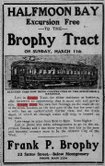 Hi June,
Hi June,